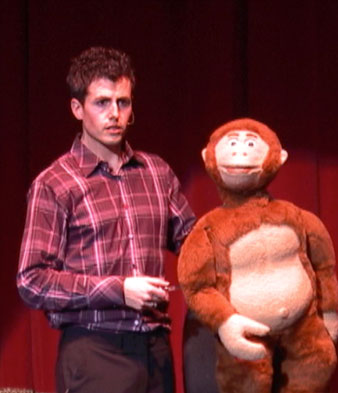 Ventriloquism is an art form that has fascinated people for centuries. It involves creating the illusion of speaking without moving the lips, making it appear as though a puppet or dummy is doing the talking.
Ventriloquism is an art form that has fascinated people for centuries. It involves creating the illusion of speaking without moving the lips, making it appear as though a puppet or dummy is doing the talking.
But how do ventriloquists talk? Ventriloquists use a combination of techniques:
- Speak without moving their lips. This is achieved by using the tongue, throat, and vocal cords to produce sounds, while keeping the lips and jaw still.
- They use the puppet or dummy to provide a visual distraction, making it appear as though the sound is coming from the figure rather than the ventriloquist.
To be successful, ventriloquists must also master the art of voice manipulation. This involves altering their voice to create different tones and pitches, allowing them to give each puppet or dummy a unique personality.
By combining these techniques, ventriloquists are able to create the illusion of a conversation between themselves and their puppets, captivating audiences and leaving them wondering how it’s all done.
Fundamentals of Ventriloquism
Art of Speaking Without Lip Movement
One of the fundamental skills of ventriloquism is the ability to speak without moving the lips. This is achieved by using the tongue, teeth, and the roof of the mouth to create the sounds of speech. The ventriloquist must also control the flow of air from the lungs to the mouth, to ensure that no sound is produced by the lips.
To master this skill, ventriloquists often practice by reciting tongue twisters or reading aloud with a cork or pen between their teeth, forcing them to use their tongue and other muscles to articulate the words. They also practice speaking in front of a mirror to ensure that their lips remain still.
Manipulating the Voice
Another key aspect of ventriloquism is the ability to manipulate the voice to create the illusion of a separate character speaking. This is achieved by altering the pitch, tone, and inflection of the voice, as well as using different accents and speech patterns.

To create a convincing character voice, ventriloquists often study the speech patterns and mannerisms of different people, including celebrities, politicians, and fictional characters. They may also use props such as a different microphone or speaker for the puppet’s voice, to further enhance the illusion of a separate character speaking.
Overall, mastering the fundamentals of ventriloquism requires a combination of technical skill, practice, and creativity. With dedication and hard work, anyone can learn the art of speaking without lip movement and creating convincing character voices.
Techniques and Skills
Mastering Diction
One of the key techniques that ventriloquists use to create the illusion of speaking without moving their lips is mastering diction. This involves being able to pronounce words clearly and precisely, even when the mouth is barely open. Ventriloquists practice saying difficult words and phrases, such as “ventriloquism” and “unique New York,” to ensure that they can articulate each syllable without moving their lips.
Controlling Breathing
 Another important skill for ventriloquists is controlling their breathing. Since they need to speak without moving their lips, they must rely on their diaphragm to produce sound. This means taking deep breaths and using the diaphragm to push air out of the lungs and into the vocal cords. Ventriloquists also need to be able to hold their breath for short periods of time to create the illusion of the puppet speaking.
Another important skill for ventriloquists is controlling their breathing. Since they need to speak without moving their lips, they must rely on their diaphragm to produce sound. This means taking deep breaths and using the diaphragm to push air out of the lungs and into the vocal cords. Ventriloquists also need to be able to hold their breath for short periods of time to create the illusion of the puppet speaking.
Utilizing the Diaphragm
The diaphragm is a muscle located beneath the lungs that helps to regulate breathing. Ventriloquists use this muscle to control the volume and tone of their voice, as well as to create different sounds and accents. By contracting and relaxing the diaphragm, they can produce a wide range of vocalizations, from soft whispers to loud shouts.
To become a skilled ventriloquist, one must practice these techniques and skills regularly. It takes time and dedication to master the art of speaking without moving one’s lips, but with enough practice, anyone can learn to do it effectively.
Ventriloquist’s Dummy
Character Development
The ventriloquist’s dummy is an essential tool for a ventriloquist. It is a puppet that is designed to look like a human or an animal, and it is used to create the illusion that the dummy is speaking. The ventriloquist gives the dummy a unique personality and voice, which helps to create an entertaining and engaging performance.
Creating a character for the dummy involves a lot of creativity and imagination. The ventriloquist must think about the personality traits, mannerisms, and quirks that will make the character interesting and memorable. They must also consider the type of audience they will be performing for and tailor the character to their preferences.
Synchronization of Movement
 One of the most important aspects of a ventriloquist’s performance is the synchronization of movement between the ventriloquist and the dummy. The ventriloquist must be able to move the dummy’s mouth and other features in a way that looks natural and convincing.
One of the most important aspects of a ventriloquist’s performance is the synchronization of movement between the ventriloquist and the dummy. The ventriloquist must be able to move the dummy’s mouth and other features in a way that looks natural and convincing.
To achieve this, the ventriloquist must practice extensively to develop their skills. They must learn how to manipulate the dummy’s mouth and other features without moving their own lips or other parts of their face. They must also be able to move the dummy’s body in a way that looks natural and convincing.
Overall, the ventriloquist’s dummy is an essential part of their performance. By developing a unique character and mastering the synchronization of movement, the ventriloquist can create an entertaining and engaging performance that will captivate audiences.
Practice and Performance
Rehearsal Strategies
 Ventriloquism requires a lot of practice to master, and there are several strategies that can help performers improve their skills. One useful technique is to practice in front of a mirror, which allows the ventriloquist to see their mouth movements and make adjustments as needed. Another helpful strategy is to record practice sessions and review the footage to identify areas that need improvement.
Ventriloquism requires a lot of practice to master, and there are several strategies that can help performers improve their skills. One useful technique is to practice in front of a mirror, which allows the ventriloquist to see their mouth movements and make adjustments as needed. Another helpful strategy is to record practice sessions and review the footage to identify areas that need improvement.
It’s also important for ventriloquists to practice speaking without moving their lips, which can be challenging at first. One technique is to place a small object, such as a toothpick or pencil, between the lips to prevent movement. With practice, ventriloquists can learn to speak without any visible lip movement.
Engaging an Audience
In addition to technical proficiency, successful ventriloquists must also engage their audience. One effective technique is to create a distinct personality for the puppet, which can help the audience connect with the character and become more invested in the performance.
Another strategy is to interact with the audience, asking questions and responding to their comments. This can help create a sense of connection and make the performance feel more interactive and engaging.
It’s also important for ventriloquists to be comfortable on stage and exude confidence. This can help captivate the audience and create a more memorable performance. With practice and a strong stage presence, ventriloquists can create a truly entertaining show.

